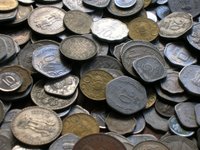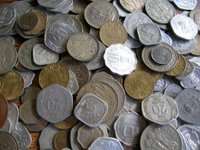 Go down Phirozeshah Mehta Road in the Fort area and almost at the end, towards Ballard Estate you will come to Amar building, which houses the RBI Monetary Museum. The entry fee to the Museum is Rs 10 (students – free) and you won’t be allowed to take cameras or bags but you can leave them in a safe deposit box at the office.
Go down Phirozeshah Mehta Road in the Fort area and almost at the end, towards Ballard Estate you will come to Amar building, which houses the RBI Monetary Museum. The entry fee to the Museum is Rs 10 (students – free) and you won’t be allowed to take cameras or bags but you can leave them in a safe deposit box at the office.This museum has a ‘rich’ (literally speaking) collection of coins and information about everything to do with money, coins, notes, currency and the RBI. The Museum brings out the great numismatic history associated with India through a time line of all dynasties, foreign rulers and princely states. Here is a virtual tour of the Museum
The Museum is divided into Six Sections
Section One: Concepts, Curiosities & the Idea of Money.
This section provides the definition of money and gives information on its evolution. It talks about the Barter system and also displays all the items that were used as commodity money including cowri shells, Neolithic stone, axes, silver bar money, knife money and beads.
Money used to be in various forms like the bent bar, the punch marked coins, canoe money, bullet money and bracelet money. Coins would be pentagonal, hexagonal, square, triangular, rectangular and of course circular.
The nomenclature of coins in India were anna, cash, dhinglo, dokdo, doudou, dub, escudo, fanam, faruqi, karshapara, kas, kon, mohur, naya paisa, pagoda, panam, pice, pie, rupia, suvarna, tanga and tanka.
Coins were made from different Metals and Alloys. Gold, Silver, Copper, Lead, Nickel and Alloys like Electrum (Gold & Silver), Billon (Copper and Silver), Alu-Mag (Nickel and Brass)
Section Two: Indian Coinage
This is the most impressive section and you can spend hours here as it displays coins through a time line right from 6-4 century B.C. to those of Independent India. It seems that the earliest documented coins of India are the silver punch marked coins which were issued around the 6th cent BC. Punch mark coins were made by punching symbols with the history or something associated with the period when they were made. Sometimes there could be up to 4 symbols punch marked on the coins. Thus, punch-marked coins were issued by the Gandhara (6-4 cent BC), Avanti (5 cent BC) and the Mauryan and Magadhan empires.

There are coins displayed of the Kuras of Kolhapur (1cent BC), Satavahana, Indo-Greek, Kushana (issued the first gold coins), Gupta (issued lots of gold coins), Early Medieval North (6-8 cent AD), Northern States-Indo-Sassanian, Kalachuris of Tripura, Early Medieval South (9-13 cent AD) like Chalukya, Kerala, and Pandyas. Coins from Delhi Sultanate and others, Sind Lodi Sur, Muhammed Bin Tughlaq, Provencial Sultanate – Bengal, Malwa, Gujrat, Madurai. (15-16 cent AD) Then the Bahmani, Adil Shah and Qutb Shah coins of the 16-17 cent AD.
During the Mughal era Sher Shah Suri (AD 1538-45) was the one who introduced monetary reforms. He standardized the silver coin by a weight standard of about one tola or 11.6 grams. Later this was the coin, which came to be known as the rupee.
Coins are displayed from the Babar, Humayun, Akbar, Shah Jahan, Aurangzeb, Shah Alam I and II, Marathas (called the gold coins hons), Awadh (had fish motifs), Sikh (had leaf mark), Shivaji and Peshwas (Ankushi rupee from Poona), Wodeyar – Chamundi (had animal motifs of lion and elephant). Northeastern States included Ahom rulers of Assam, Manikyas of Tripura (oct
 agonal shape coins)
agonal shape coins)The Post Uprising Regional States had coins with the Mughal rulers name with the name or portrait of the ruler of England on their coins. In 1947 Hyderabad, Mewar, Jaipur, Travancore, Kutch, Gwalior, Jodhpur, Indore and Baroda were still issuing their own coins.
Then there is a whole section on The Indo-European Coinage (Portuguese, Dutch, Danish, French and the East India Company with denominations of the pie, 1/2 anna, copperron, pice, ½ pice, ½ anna, star pagoga, dub, sicca rupee, ½ rupee, 1/3 rupee, ½ rupee. It continues with British India Coinage, Coinage from Republic India and Commemorative Coins (IX Asian Games series, Chattrapati Shivaji Maharaj Series etc)
They have tried to make this section somewhat interactive with two information kiosks with a lot of information and also interactive games for children like match the currency with the country and so on.
Section Three: Coins to Bank Notes and Section Four : Indian Paper Money
This section deals with the transition of coins to Bank Notes. It displays Promissory Notes, Cheques, Bills of Exchange, Hundies and Early Bank Notes. Notes issued by the Bank Of Bengal (Unifaced, Commerce and Britannia series), Bank Of Bombay, British India notes with hand-made paper of denominations of 10,20, 50,100, 500 and 1000 have been displayed. There are notes from the Underprint series (1903-1911), small denomination notes of November 1917 of a rupee two annas eight, King portrait series, first notes issued by RBI in 1938, first notes issued after Independence to the current RBI notes. The display also incudes representative notes of the Princely States and a collection of exigent money.
Section Five: Know Your Currency

This section talks about how currency is managed in India and the features of the contemporary Mahatma Gandhi Series of notes.
Section Six: RBI and You
This section covers everything you wanted to know about the RBI and didn’t know whom to ask. There are portraits of all the governors of the RBI – right from Sir Osborne A Smith ( the first Governor ) to the current Y V Reddy. It displays the functions of the central bank of the country, its role in the economy and how it touches the day-to-day life of the common man.
So if you are interested in the history of our money and have at least 2-3 hours to spare do visit this museum. The timings are Monday to Friday: 10:30 to 17:00 hrs and Saturday: 10:30 to 13:00. The Museum is unfortunately closed on Sundays and Bank Holidays.
7 comments:
Way to go, Abodh! Really enjoyed this piece. I be working in Ballard Estate from Oct 3. Will definitely make it point to go to the museum. Anne
R.B.I. authority is requested to organise exhibition of antique coins in the important cities of India for diffusion of knowledge of people from all walks of life.
Grateful to Google search engine for delivering any item at once with one click of mouse, even small child can get any information without any problem from vast treasure of Google.
R.B.I. authority is requested to organise exhibition of antique coins at the important cities of India for diffusion of knowledge of people from all walks of life.
Grateful to Google search engine for delivering any item at once one click of mouse even small child can get any information without any problem from vast treasure of Google.
thanks, this was very helpful.
i've been going that side for ages now, and i had no clue this existed.
highly recommended.
Mithran Sudhir.
awesome dude!!
Interesting article, nice to see spread of awareness of one of few coin museums left.
Disappointing to see no cameras are allowed inside. Would love to see this place being advertised more and turned into a tourist attraction like some are around the globe!
Btw nice representational pics :)
What are the timing of the museum? Please post them if you know. Thanks for the great article.
Post a Comment